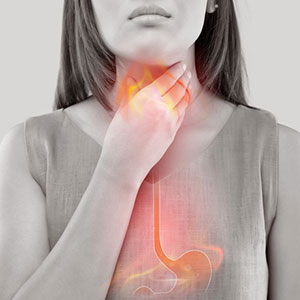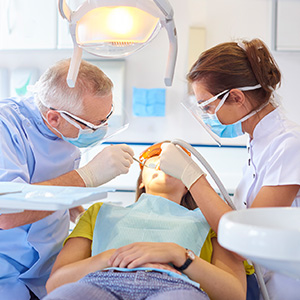
Heartburn is a big problem: Each year we Americans spend around $10 billion on antacid products, twice as much as for over-the-counter pain relievers. It's an even bigger problem because many indigestion sufferers actually have acid reflux or GERD (gastroesophageal reflux disease), a chronic disease that can cause physical harm—including to teeth.
That's why we've joined with other healthcare providers for GERD Awareness Week, November 17-23, to call attention to the causes and consequences of this disease. In addition to the harm it poses to the esophagus (the “tube” leading from the mouth to the stomach through which food passes), GERD could also damage your teeth to the point of losing them.
GERD is usually caused by the weakening of the lower esophageal sphincter, a ringed muscle located at the junction between the esophagus and the stomach. It acts as a “one-way valve” allowing food into the stomach, but not back into the esophagus. If it weakens, powerful stomach acid can come back into the esophagus and possibly even the mouth. The latter scenario poses a danger to teeth's protective layer of enamel.
Although tough and durable, enamel softens after prolonged contact with acid. Oral acid isn't all that unusual—acid levels typically rise right after eating, causing a temporary softening of enamel. Our saliva, however, goes to work to bring down those acid levels and stabilize enamel.
But if stomach acid enters the mouth because of GERD, the increased acidity can overwhelm saliva's ability to neutralize it. This can lead to enamel erosion, tooth decay and ultimately tooth loss. The enamel damage can be so pronounced that dentists are often the first to suspect GERD.
If you're diagnosed with GERD, here's what you can do to protect your teeth.
- Manage your GERD symptoms through medication, avoidance of spicy/acidic foods, alcohol, caffeine or tobacco products, and maintaining an optimum weight;
- Stimulate saliva by drinking more water, using saliva boosters, or (with your doctor's consent) changing from medications that may be restricting saliva flow;
- Speak with your dentist about strengthening your enamel with special toothpastes or mouthrinses containing extra fluoride or amorphous calcium phosphate (ACP).
You should also brush and floss daily to lower your risk of dental disease, but with one caveat: Don't brush your teeth during or immediately after a reflux episode, as you might remove microscopic bits of softened enamel. Instead, rinse your mouth with water mixed with a half-teaspoon of baking soda (an acid neutralizer) and wait about an hour to brush. The extra time also gives saliva time to further neutralize any remaining acid.
GERD can be unpleasant at best and highly destructive at worst. Don't let it ruin your teeth or your smile.
If you would like more information about GERD and dental health, please contact us or schedule a consultation. To learn more, read the Dear Doctor magazine articles “GERD and Oral Health” and “Dry Mouth.”

Thousands of years ago, our ancestors could only expect to live between 30 and 40 years. But steady improvements in lifestyle and medical care have increased human life expectancy to almost 80 years.
Although a welcome development, it does raise a question: Are our teeth up to the added years? Even though quite resilient, it's natural for teeth to wear after years and tens of thousands of meals biting and chewing.
Fortunately, there have also been phenomenal advances in dental restorations that can effectively replace teeth we lose along the way. Even so, the most advanced artificial replacements can't restore the full benefit of natural teeth to oral and general health. The ideal goal is to preserve and protect our natural teeth for as long as possible.
Here are 4 areas worthy of your attention in protecting your teeth throughout your lifetime.
Dental disease. Tooth decay and periodontal (gum) disease are the top causes for poor dental health and tooth loss. They're caused by bacteria living and feeding primarily in dental plaque, a thin biofilm on tooth surfaces. Brushing and flossing daily, along with regular dental cleanings, removes this disease-causing plaque. You should also seek treatment as soon as possible at the first sign of dental disease.
Bite correction. A poor bite is more than a smile problem: Teeth out of alignment and not engaging normally with their counterparts on the other jaw may increase tooth wear and make hygiene more difficult to perform. Orthodontic treatment, even if undertaken later in life, can help maintain your teeth's long-term health and longevity.
Bad habits. Your teeth are tough, but not indestructible. Protect them by avoiding harmful habits or practices like crunching ice, gnawing on pencils, nails or other hard objects, cracking open nuts or using your teeth as tools. Not engaging in these kinds of habits will help reduce wear and help you also avoid chipping and fractures.
Teeth grinding. Involuntarily clenching or grinding your teeth, often while sleeping, can accelerate dental wear. If you suspect you have this habit, take steps first to deal with stress, the number one cause of adult teeth grinding. Your dentist can also fashion a mouth guard that prevents your teeth from making solid contact with each other and thus help reduce wearing to your teeth.
If you would like more information on tooth wear, please contact us or schedule an appointment for a consultation. You can also learn more about this topic by reading the Dear Doctor magazine article “How and Why Teeth Wear.”

Even though coronavirus lockdowns have prevented TV hosts from taping live shows, they're still giving us something to watch via virtual interviews. In the process, we're given occasional glimpses into their home life. During a Tonight Show interview with Seahawks quarterback Russell Wilson and his wife, R & B performer Ciara, Jimmy Fallon's daughter Winnie interrupted with breaking news: She had just lost a tooth.
It was an exciting and endearing moment, as well as good television. But with 70 million American kids under 18, each with about 20 primary teeth to lose, it's not an uncommon experience. Nevertheless, it's still good to be prepared if your six-year-old is on the verge of losing that first tooth.
Primary teeth may be smaller than their successors, but they're not inconsequential. Besides providing young children with the means to chew solid food and develop speech skills, primary teeth also serve as placeholders for the corresponding permanent teeth as they develop deep in the gums. That's why it's optimal for baby teeth to remain intact until they're ready to come out.
When that time comes, the tooth's roots will begin to dissolve and the tooth will gradually loosen in the socket. Looseness, though, doesn't automatically signal a baby tooth's imminent end. But come out it will, so be patient.
Then again, if your child, dreaming of a few coins from the tooth fairy, is antsy to move things along, you might feel tempted to use some old folk method for dispatching the tooth—like attaching the tooth to a door handle with string and slamming the door, or maybe using a pair of pliers (yikes!). One young fellow in an online video tied his tooth to a football with a string and let it fly with a forward pass.
Here's some advice from your dentist: Don't. Trying to pull a tooth whose root hasn't sufficiently dissolved could damage your child's gum tissues and increase the risk of infection. It could also cause needless pain.
Left alone, the tooth will normally fall out on its own. If you think, though, that it's truly on the verge (meaning it moves quite freely in the socket), you can pinch the tooth between your thumb and middle finger with a clean tissue and give it a gentle tug. If it's ready, it should pop out. If it doesn't, leave it be for another day or two before trying again.
Your child losing a tooth is an exciting moment, even if it isn't being broadcast on national television. It will be more enjoyable for everyone if you let that moment come naturally.
If you would like more information on the importance and care of primary teeth, please contact us or schedule a consultation. To learn more, read the Dear Doctor magazine article “Importance of Baby Teeth.”

We Americans love our sports, whether as participants or spectators. But there's also a downside to contact sports like soccer, football or basketball: a higher risk of injury, particularly to the mouth and face. One of the most severe of these is a knocked out tooth.
Fortunately, that doesn't necessarily mean it's lost: The tooth can be reinserted into the empty socket and eventually return to normal functionality. But it must be done as soon as possible after injury. The more time elapses, the lower the chances of long-term survival.
That's because of how teeth are held in place in the jaw, secured by an elastic, fibrous tissue known as the periodontal ligament. When a tooth is knocked out some of the ligament's periodontal cells remain on the tooth's root. If these cells are alive when the tooth is reinserted, they can regenerate and reestablish attachment between the ligament and the tooth.
Eventually, though, the cells can dry out and die. If that has already happened before reinsertion, the tooth's root will fuse instead with the underlying bone. The tooth may survive for a short time, but its roots can eventually dissolve and the tooth will be lost.
Your window of opportunity for taking advantage of these live periodontal cells is only 5-20 minutes with the best chances in those earlier minutes. You should, therefore, take these steps immediately after an injury:
- Find the tooth, hold it by the crown (not the root end), and rinse off any debris with clean water;
- Reinsert the root end into the empty socket with firm pressure;
- Place clean gauze or cloth in the person's mouth between the tooth and the other jaw, and ask them to bite down gently and hold their bite;
- Seek dental or emergency medical care immediately;
- If you're unable to reinsert the tooth, place it quickly in a container with milk and see a dentist immediately.
You can also obtain an Android or IOS smartphone app developed by the International Association of Dental Traumatology called ToothSOS, which will guide you through this process, as well as for other dental emergencies. The quicker you act, the better the chances that the injured person's knocked out tooth can be rescued.
If you would like more information on what to do in a dental emergency, please contact us or schedule an appointment for a consultation. You can also learn more about this topic by reading the Dear Doctor magazine article “When a Tooth is Knocked Out.”

After years battling disease, your troubled tooth reached its useful life's end. It's been extracted, and we've replaced it with a life-like dental implant. So now, as far as the implant goes, disease is no longer an issue…right?
Sorry, no—though not to the same degree as a natural tooth, an implant could be endangered by gum disease. Although the implant's materials can't be infected, the supporting gums and bone can.
In fact, there's a particular type of gum disease associated with implants known as peri-implantitis (“peri” around an implant; “itis” inflammation) that first affects the gums surrounding an implant. Although peri-implantitis can arise from an excess of dental cement used to affix the crown to the implant, it most commonly starts like other forms of gum disease with dental plaque.
Dental plaque, and its hardened form calculus (tartar), is a thin, bacterial biofilm that builds up on teeth surfaces. It can quickly accumulate if you don't remove it every day with proper brushing and flossing. The bacteria living in plaque can infect the outer gum tissues and trigger inflammation.
Gum disease around natural teeth can spread quickly, but even more so with implants. That's because the natural attachment of the gums helps supply antibodies that impede infection. Implants, relying solely on their connection with the bone, don't have those gum attachments. As a result, peri-implantitis can move rapidly into the supporting bone, weakening the implant to the point of failure.
The good news, though, is that peri-implantitis can be treated successfully through aggressive plaque removal and antibiotics. But the key to success is to catch it early before it progresses too far—which is why you should see your dentist at the first sign of gum swelling, redness or bleeding.
You can also prevent peri-implantitis by practicing daily brushing and flossing, including around your dental implant. You should also see your dentist twice a year (or more, if they advise) for cleanings and checkups.
Dental implants overall have a greater than 95% success rate, better than any other tooth restoration system. But they still need daily care and regular cleanings to ensure your implants are on the positive side of those statistics.
If you would like more information on caring for your dental implants, please contact us or schedule an appointment for a consultation.
This website includes materials that are protected by copyright, or other proprietary rights. Transmission or reproduction of protected items beyond that allowed by fair use, as defined in the copyright laws, requires the written permission of the copyright owners.
